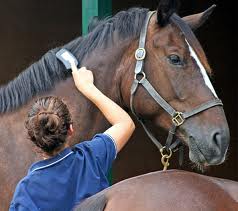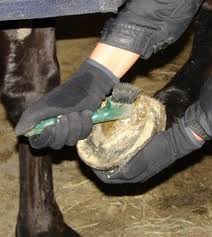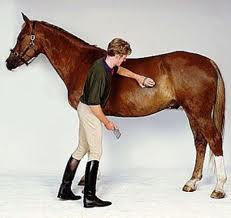|
Grooming your Horse

Supplies You will need a few basic supplies for grooming your horse:
Body or finishing brush: A brush with soft bristles for use on sensitive areas like the face and legs and for giving your horse’s body a final polish. Curry comb: A comb to loosen dirt and hair. Look for one that is round and made from plastic or rubber. Dandy or stiff brush: A brush to loosen dirt, hair, and caked mud from the coat is essential when grooming your horse. Use a stiffer brush in the winter, when your horse will have a thicker coat, and one with softer bristles in the summer, when he will have a thinner coat. Hoof pick: An item used to remove rocks and other debris from the hooves. Mane comb: A comb for the mane. metal combs are best because these will last longer. Shedding blade: A serrated metal blade for loosening hair from your horse’s coat. Tail brush: This can be either a brush made specifically for a horse or one for human hair.
Towels: Clean towels have countless uses when grooming your horse. They can be just a standard towel, be sure to wash them regularly.
After you have loosened the dirt and hair, use a brush to remove it. If using two brushes, use the stiffer one first but avoid brushes with extremely hard bristles. Start on the neck and brush with the hair, working from front to back. Be sure to clean the horse's belly where the cinch lies to prevent saddle sores. The stiff brush also can be used in a side-to-side motion to remove mud on the feet and legs, but it may be necessary to wash mud from the lower legs rather than groom roughly to remove it. Use a soft brush to put on the finishing touches and to brush the face. Start on top of the forehead and be careful around the eyes, mouth and nose. Avoid placing your face over or too close to the horse's face, as the animal can move its head quickly and hit you.
Stand near and to the side of the hind leg when grooming your horses hindquarters and brushing the tail. When working in the flank and loin areas, get a feel for your horse's reaction. If it shows anxiety, work on these areas more gently. Use the soft brush on the mane and tail. If there are tangles, it is best to pick through them with your fingers, but you also may use a mane comb.
When moving behind the horse, walk as closely to it as possible, keeping a hand on it at all times. If it kicks, you will be hurt less because the kick has not had time to gain full momentum. Walking only a few feet behind the horse is unsafe because you will receive the kick with full force. If you do not want to walk closely, move far enough away so that there is no chance of getting kicked, and make sure the horse is aware of your presence when you approach the other side. When working with a horse in a stall, walk closely because you will not have enough room to move clear. When working with a spooky or unfamiliar horse, stand to the side and run your hands over its hindquarters to get a feel for its reaction.
When grooming your horse do not climb over or under the lead line of a tied horse. The horse may pull back and cause you to trip over the line, and you will have no quick escape should the horse lunge forward, paw or try to bite. Never walk under the belly of any horse. If your horse wears a cribbing strap, remove it before working with the horse, particularly when performing tasks that could scare it, such as trimming with electrical clippers.

Cleaning the feet
Hoofs should be cleaned daily and trimmed or reshod every four to six weeks. Pick out your horse's feet each time you handle it and before and after each ride. Start with the left front and work around to its right front, since most horses are accustomed to this order. Facing the rear of the horse, place your near hand on its shoulder and rub down its leg with your other hand. If it does not pick up its foot, push on its shoulder to shift its weight, or squeeze the tendons above the fetlock until it picks up its foot. If you try to force the foot up, it is likely that the horse will lean on you or lose its balance.
As the foot yields, slip your outside hand in front of the foot and raise it to knee height promptly, but without jerking. Hold the foot firmly enough that the horse cannot jerk its foot away from you. If the horse gets anxious and struggles, put the foot down and start over. Be sure your feet are not placed where it will step on them if it pulls away.
Use the hoof pick in a downward motion toward the toe. Use the hoof pick in a downward motion toward the toe. Never use the hoof pick from toe to heel because it is more likely to get caught in a crevice and puncture the sole or frog if the foot is jerked from your grasp. Clean the sole, the frog and the crevices around the frog well. Look for bruises, punctures, foreign objects or signs of disease. If you find a problem, consult your veterinarian or farrier.
To clean the hind feet, place your near hand on the horse's hip to shift its weight. Run your other hand down the back of its leg to the fetlock, using the same procedure as with the front feet to ask it to lift its foot. As the horse picks up its foot, slip your hand around it. Pull the foot slightly backward and lift it up, either cradling it in your hand or resting it on your inside knee. Allow the horse to relax in the position that is most comfortable for it. Do not force the foot too high or pull it too far back, as this will put the horse off balance. Position yourself so that you will not end up behind the horse if it struggles. When you put the foot down, release it slowly, making sure not to drop it.
Source: W. Loch, grooming your horse.
Return from Grooming-your-Horse to Horse Riding Connection
|
 Begin grooming your horse with a rubber currycomb, which is more gentle than a metal one. Start on the neck and brush in a circular motion. Work from front to back, grooming carefully in bony areas. Avoid using the currycomb on the face, lower legs or flanks. You may use a shedding blade to remove shedding hair but be very gentle, especially on bony areas or if the horse is muddy. Do not use the shedding blade on the mane, tail or legs. Never sit on the ground or groom from your knees and always be in a position to move away quickly. When grooming your horse do not hurry, especially with a young or spooky horse.
Begin grooming your horse with a rubber currycomb, which is more gentle than a metal one. Start on the neck and brush in a circular motion. Work from front to back, grooming carefully in bony areas. Avoid using the currycomb on the face, lower legs or flanks. You may use a shedding blade to remove shedding hair but be very gentle, especially on bony areas or if the horse is muddy. Do not use the shedding blade on the mane, tail or legs. Never sit on the ground or groom from your knees and always be in a position to move away quickly. When grooming your horse do not hurry, especially with a young or spooky horse.
